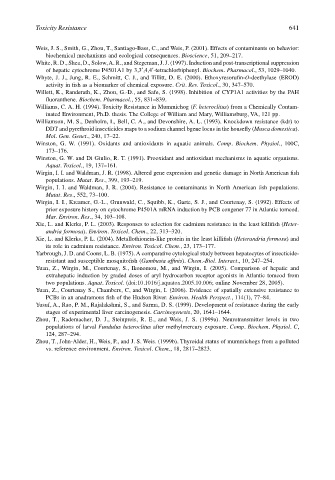Page 661 - The Toxicology of Fishes
P. 661
Toxicity Resistance 641
Weis, J. S., Smith, G., Zhou, T., Santiago-Bass, C., and Weis, P. (2001). Effects of contaminants on behavior:
biochemical mechanisms and ecological consequences. Bioscience, 51, 209–217.
White, R. D., Shea, D., Solow, A. R., and Stegeman, J. J. (1997). Induction and post-transcriptional suppression
of hepatic cytochrome P4501A1 by 3,3′,4,4′-tetrachlorbiphenyl. Biochem. Pharmacol., 53, 1029–1040.
Whyte, J. J., Jung, R. E., Schmitt, C. J., and Tillitt, D. E. (2000). Ethoxyresorufin-O-deethylase (EROD)
activity in fish as a biomarker of chemical exposure. Crit. Rev. Toxicol., 30, 347–570.
Willett, K., Randerath, K., Zhou, G.-D., and Safe, S. (1998). Inhibition of CYP1A1 activities by the PAH
fluoranthene. Biochem. Pharmacol., 55, 831–839.
Williams, C. A. H. (1994). Toxicity Resistance in Mummichog (F. heteroclitus) from a Chemically Contam-
inated Environment, Ph.D. thesis. The College of William and Mary, Williamsburg, VA, 121 pp.
Williamson, M. S., Denholm, I., Bell, C. A., and Devonshire, A. L. (1993). Knockdown resistance (kdr) to
DDT and pyrethroid insecticides maps to a sodium channel bgene locus in the housefly (Musca domestica).
Mol. Gen. Genet., 240, 17–22.
Winston, G. W. (1991). Oxidants and antioxidants in aquatic animals. Comp. Biochem. Physiol., 100C,
173–176.
Winston, G. W. and Di Giulio, R. T. (1991). Prooxidant and antioxidant mechanisms in aquatic organisms.
Aquat. Toxicol., 19, 137–161.
Wirgin, I. I. and Waldman, J. R. (1998). Altered gene expression and genetic damage in North American fish
populations. Mutat. Res., 399, 193–219.
Wirgin, I. I. and Waldman, J. R. (2004). Resistance to contaminants in North American fish populations.
Mutat. Res., 552, 73–100.
Wirgin, I. I., Kreamer, G.-L., Grunwald, C., Squibb, K., Garte, S. J., and Courtenay, S. (1992). Effects of
prior exposure history on cytochrome P4501A mRNA induction by PCB congener 77 in Atlantic tomcod.
Mar. Environ. Res., 34, 103–108.
Xie, L. and Klerks, P. L. (2003). Responses to selection for cadmium resistance in the least killifish (Heter-
andria formosa). Environ. Toxicol. Chem., 22, 313–320.
Xie, L. and Klerks, P. L. (2004). Metallothionein-like protein in the least killifish (Heterandria formosa) and
its role in cadmium resistance. Environ. Toxicol. Chem., 23, 173–177.
Yarbrough, J. D. and Coons, L. B. (1975). A comparative cytological study between hepatocytes of insecticide-
resistant and susceptible mosquitofish (Gambusia affinis). Chem.-Biol. Interact., 10, 247–254.
Yuan, Z., Wirgin, M., Courtenay, S., Ikonomou, M., and Wirgin, I. (2005). Comparison of hepatic and
extrahepatic induction by graded doses of aryl hydrocarbon receptor agonists in Atlantic tomcod from
two populations. Aquat. Toxicol. (doi:10.1016/j.aquatox.2005.10.006; online November 28, 2005).
Yuan, Z., Courtenay S., Chambers, C, and Wirgin, I. (2006). Evidence of spatially extensive resistance to
PCBs in an anadramous fish of the Hudson River. Environ. Health Perspect., 114(1), 77–84.
Yusuf, A., Rao, P. M., Rajalakshmi, S., and Sarma, D. S. (1999). Development of resistance during the early
stages of experimental liver carcinogenesis. Carcinogenesis, 20, 1641–1644.
Zhou, T., Rademacher, D. J., Steinpreis, R. E., and Weis, J. S. (1999a). Neurotransmitter levels in two
populations of larval Fundulus heteroclitus after methylmercury exposure. Comp. Biochem. Physiol. C,
124, 287–294.
Zhou, T., John-Alder, H., Weis, P., and J. S. Weis. (1999b). Thyroidal status of mummichogs from a polluted
vs. reference environment. Environ. Toxicol. Chem., 18, 2817–2823.

